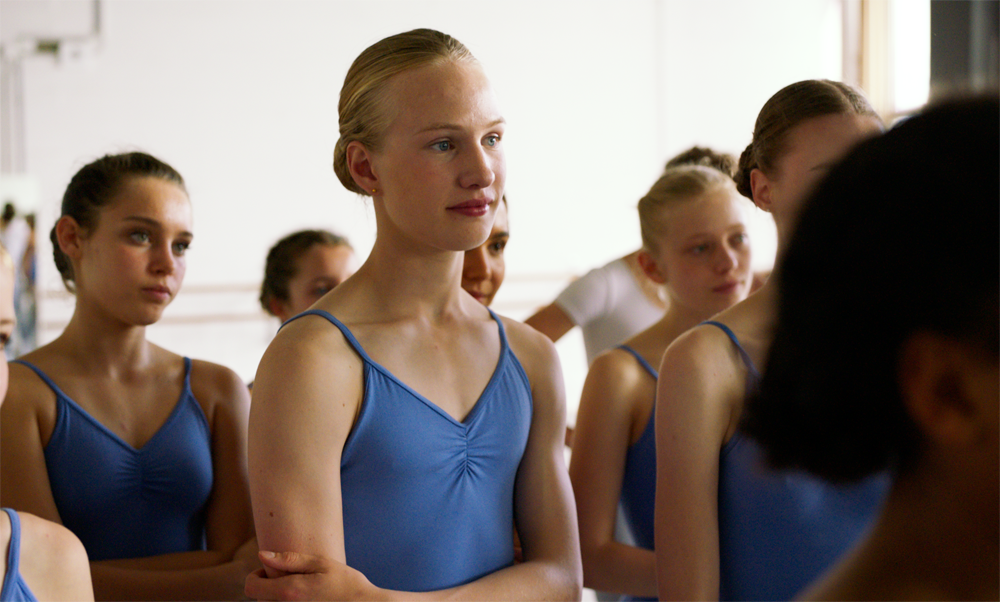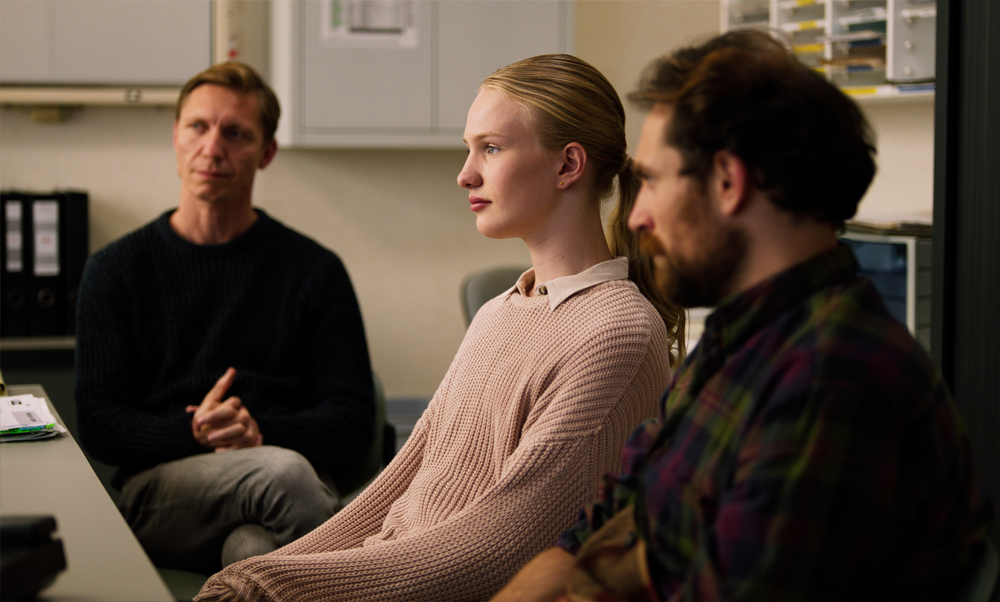A Strange Sight
Girl by Lukas Dhont

In the cinema, a film is first and foremost experienced alone, without any insight into the emotional lives of the other visitors. The spectator nestles in his seat, the projector switches on and casts a cone of light into the theatre. Then, figures appear on the screen, moving forms that are also human beings, creatures of flesh and blood that can be watched unabashedly in the privacy of the film theatre. As moving surfaces, the desires of those figures always retain something inscrutable. The shadow play, both seeming and all too real, raises a riddle to the viewer, who can only guess at the depth of what is being shown. Within that experience, the embarrassment about one’s own feelings, lies the very root of the plural. One always watches together with others, with other spectators, but also more broadly with a group or a community. Around that secret but shared experience, an involvement is woven, a negotiation of desires and fears with those other people and those strange creatures on the screen.
The secret community of viewers and the strangeness of the characters on the screen are the two axioms to which Girl (2018), Lukas Dhont’s film debut, owes its existence. The screen shows the body of Lara/Victor, a fifteen-year-old aspiring ballerina who wants to become a girl biologically. Girl is a tactile experience, a travelogue wanting to impart Lara’s struggle with her body to the spectator.
Girl feels out Lara’s gender change in two registers. On the one hand, there is Lara’s wish to transform her body. She wants to embody her femininity. On the other, there is the social process of adjustment. In that, Lara’s environment – public (society), semi-public (family, friends and school) or private (individual) – has to adapt to her new identity.
To give a full and tangible rendition of Lara’s struggle, Girl is situated in three symbolic locations, each with their own degree of intimacy and visibility. Alternately, the places serve as metaphors for the private, the semi-public and the public: the father’s apartment, the ballet school and the metro. The spaces organize the course of the film. Lara is doing a trial period at a ballet school, where she has to fight for a permanent spot, just like she has to fight for a permanent spot within society. It proves to be a very effective narrative choice. By staging her adaptation process both in the ballet school and in the bedroom, the physical intensity of Lara’s transition is augmented. We do not only see someone who tries to transform a body at all costs. We also see someone fighting the boundaries of that same body for art’s sake, who goes beyond every boundary just to perform that one pointe. For a ballerina, surpassing nature’s laws is a life goal. The same applies to Lara’s transition, which is a struggle against a physical outside world.

The ballet school also plays another role in Girl. With its strict hierarchy and rigid demands, ballet is the best metaphor for any social order. Within the cosmos of a ballet school, the film thus stages the encounter between the individual and the community. In Girl, the community in question shows little sign of resisting her plans. Intendants and teachers offer Lara every opportunity as a student and assist her in her ordeal. They follow her situation through conversations and consultations. Because the real problem seems to lie with Lara herself, who just doesn’t seem to come to terms with that temperamental body, and in the first place with her sex organ, which reminds her of her masculinity time and again. Society is prepared to follow her. The body not quite.
In spite of these three realms, Girl focuses on the private. The vast majority of the film is set in the home environment of her father’s apartment. This space unfolds like a house with many rooms, from the kitchen to the living room to the toilet, each with their own shade of privacy. In Girl, the public space primarily presents itself as a transit zone: Lara taking the metro, walking on the street, strolling down the corridor. The social sphere in Girl is mainly a stopover on the journey from one private area to another. The same goes for the characters. If there are any public figures in Girl, they are people with a semi-private practice: Lara visits the doctor, the psychologist; Lara is coached by her dance instructor. They are social roles without a true public nature. These surveyors have pledged an oath of secrecy and offer Lara a stage for her inner self. In one mere scene, a teacher confronts the class with Lara, asking other students whether he can refer to Lara as a “girl.” Except for a momentary confrontation at a party with her classmates, we witness no other instances of friction.
That limitation is easily explained. Girl wants to avoid the cliché treatment of the transgender subject, characterized by an often hysterical morality and most strongly expressed in the format of the television talk show, where a transgender, as a “basket case”, is only allowed to play a limited number of roles. The first is the trans person’s participation in the public debate in function of a certain gender diplomacy. As an “ambassador” of his or her community, he or she is urged to sway new gender companions, resulting in sensitive discussions about “real” women and “real” men. The other role is about the approbation of a certain desire, the right to experience one’s own gender alongside existing forms. That option is also political, and both require public persuasion and confrontation. In both cases, the transgender person is put in an awkward position, in which her desire’s legitimacy must be publicly discussed.
Girl opts for a different starting point. In the film, Lara’s social adaptation has already taken place. Lara has a supportive father who assists his daughter. She has a small brother who acknowledges her role as a caring sister. She has a circle of loved ones and relatives, relatives of her father, who assist her in her daily duties. Lara is dear to their hearts because of her domestic virtues: preparing meals, rocking her little brother to sleep, and acting as a hostess. Outside the home too the integration in Girl has already taken place. At the ballet school, Lara belongs to a group of adolescents who involve her as an average girl of fifteen in their adolescent behaviour. So Lara has acquired her positions. She is a daughter, sister, mother figure, friend and ballet student.
That strategy is also expressed formally. The use of an explicit physicality, a caressing camera and autumn-coloured light creates a well-considered sense of security for Lara. The relief of the film’s sound is soft. It has a cautious rhythm, with a fragile vocal timbre and a stammering articulation for the main character. That intimacy and fragility also offer a steady point of departure for the film’s narrative. Girl is a chain of slices of life, a series of snapshots with gender struggle as its connecting thread. Several scenes highlight the mundanity of Lara’s life. We see a party with people doing ordinary things, a dinner with family, a cup of coffee in the kitchen, classroom frivolity. Girl avoids the visibility of the public sphere and refuses the direct intimidation of the political. Instead of instruction, the film offers an intimate account of gender change. The real work is mainly done by Lara herself, in a safe environment. Just like in her ballet training, she has to compete against a tenacious body. Her femininity is possible, but she does have to work for it, as for her dance career.
Girl wants to combat clichéism – especially that of gender as a social “issue”. At the same time, the film never completely breaks away from its thematic starting point. A film carrying the title Girl has an agenda. However, that agenda is indeed not presented through loud declamations or statements. Other means are used, mainly an explicit form of subjectivity, expressed in a series of elaborate scenes in which Lara watches and scans herself in the mirror, in the bathroom at home or in the dance hall. The mirrors do not only turn her into a bystander of her own journey. They also draw in the viewer, who is allowed an intimate look at her inner self. In this way, the viewer can take up a more comprehensive position on the “trans issue”. Sympathy – or even stronger, compassion – seems to be the purpose here.
To evoke such empathy, the physical experience of Lara’s suffering is mobilized strategically. The suffering intimidates the viewer. There’s no way around it. The vehemence of a gender transformation is not built into a discourse or is not the result of a narrative here. Lara’s suffering is shifted to a place outside of the story itself, as a reality that doesn’t need deciphering. The intensity of the ordeal already presents itself at the start of the film and is then sustained in tight crescendo. The experienced cruelty has little to do with social violence. It rather feels like an ironed horror effect, which, like all horror, works by means of anticipation and suggestive coercion. Once the viewer becomes aware of the physicality of Lara’s suffering, he or she remains wary of a further increase, a sudden uplift or twist or turn. Girl thrives on a constant qui vive.

Despite all good intentions, this primarily turns Girl into a tribunal. The film underlines Lara’s suffering as a given fact. And facts serve as evidence. The daily life in the film – the cup of coffee in the kitchen, the conversations with the psychiatrist, the sessions with the teachers – serves to arrive at a certain understanding of what today’s transgenders are experiencing and why this deserves compassion. In other words, Girl thrives on impersonal voyeurism. Not unlike the scenes in front of the mirror, the scenes with the doctor, psychologist and dance teacher turn the audience into bystanders of a process of certification. When Lara, at the end of her journey, confidently looks into the camera in a Brussels metro station, she also looks us, her “jury”, straight in the eyes. It’s as if she knew all along that someone had been watching in the background. “Here I am,” she seems to say, “now you know what I’ve been through. Now I can come to terms with myself.”
The spectator dares no longer question so much suffering. Who am I to deny all of this? Lara’s integration into our social world happened so promptly, so suddenly, by appealing to our bodily reflexes. But perhaps the body is also a vulnerable instrument. Once the projection stops, the light in the film theatre switches back on, and the suffering disappears, the danger of incomplete participation is looming. We have experienced a lot in the film theatre, both together and alone – but then what?
Girl ends with a happy Lara. After a desperate act of self-mutilation, Lara’s facial expression went from unhappy to happy. How that change came about remains an enigma. Despite everything, Girl’s thin storyline has remained unfinished. The actual intention of the film becomes clear in that confusion. Girl’s physicality took over the possibility of a narrative, seeing that the narrative itself was not allowed to take place. That would be television and too close to the field of representation. But along the way the zeal to bypass the public, to avoid representation at all costs, immerses the film in an oppressive mist of compassion, which merely circles Lara’s status as an exception. Girl is progressive in its plea for the universal recognition of transgenders. But the film can only guard that universality by calling upon an extreme particularity, which is Lara’s extraordinary heroism as an individual. The film guarded itself against the public sphere in which citizens judge, criticize but also engage fellow citizens. Girl relegates that space to the private. Lara’s suffering is far from anti-political, however. Although it addresses us in a place outside of space and time, it still addresses, begs for a collective response. Lara’s private world is not truly private. That would be impossible, as this private world must necessarily present itself as a social utopia, an explicitly public ideal. The characters surrounding Lara take up explicit positions; the father, teachers and friends represent a society that has entered the public arena and has to judge a suffering being. If society cannot understand, then it must feel – in this case, collectively in the film theatre.
But what if society cannot always feel it and what if that’s not necessarily a problem? And what if it does want to understand, and what if it is a problem that the film barely helps it in that task? In the pursuit of an absolute recognizability, Lara in Girl becomes unrecognizable indeed. By pushing the world out of the picture, Girl eventually pushes Lara herself out of the world. A strange sight remains a strange sight.

Images from Girl (Lukas Dhont, 2018)

